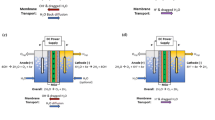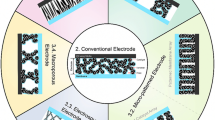Abstract
Novel sulfonic acid-functionalized chitin nanowhiskers (sChW) with enhanced proton conductivity were prepared for fabricating green and environmentally friendly chitosan (CS)-based nanocomposite polymer electrolyte membranes (PEMs). The performance of sChW in the development of direct methanol fuel cell (DMFC) nanocomposite membranes was also assessed. The manufactured nanocomposite membranes were characterized by Fourier transform infrared spectroscopy (FTIR), transmission electron microscopy (TEM), field emission scanning electron microscopy (FESEM), CHNS elemental analysis, X-ray diffractometry (XRD), ion-exchange capacity (IEC), water uptake, as well as proton conductivity and methanol permeability. The results showed that modification of chitin nanowhiskers (ChW) with sulfonic acid groups, as the proton-conducting sites, could enhance proton conductivity of the manufactured membranes, leading to a fall in methanol permeability, as a result of attractive interactions between the negatively charged sulfonic acid groups on the surface of sChW and the positively charged amine groups in the chitosan chains. Thus, the selectivity parameter (the ratio of the proton conductivity to methanol permeability) of the chitosan-based nanocomposite membranes significantly increased from 3900 for pristine chitosan PEM to 26,888 S.s.cm−3 (ca. 6.8 times) for a membrane with 5% (wt) sChW. The functionalization strategy used herein can pave the way for the development of efficient polyelectrolyte membranes for applications in direct methanol fuel cells.








Similar content being viewed by others
References
Bashir S, Liu JL (2015) Advanced nanomaterials and their applications in renewable energy. Elsiver, Amsterdam
Shirdast A, Sharif A, Abdollahi M (2016) Effect of the incorporation of sulfonated chitosan/sulfonated graphene oxide on the proton conductivity of chitosan membranes. J Power Sources 306:541–551
Tohidian M, Ghaffarian SR, Shakeri SE, Bahlakeh G (2013) Sulfonated aromatic polymers and organically modified montmorillonite nanocomposite membranes for fuel cells applications. J Macromol Sci B 52:1578–1590
Mukoma P, Jooste B, Vosloo H (2004) A comparison of methanol permeability in Chitosan and Nafion 117 membranes at high to medium methanol concentrations. J Membr Sci 243:293–299
Tenson TJ, Baby R (2017) Recent advances in proton exchange membrane fuel cells: a view. Int Adv Res J Sci Eng Tech 4(6):34–40
Singh D, Lu D, Djilali N (1999) A two-dimensional analysis of mass transport in proton exchange membrane fuel cells. Int J Eng Sci 37:431–452
Zakaria Z, Kamarudin SK, Timmiati S (2016) Membranes for direct ethanol fuel cells: an overview. Appl Energy 163:334–342
Shakeri SE, Ghaffarian SR, Tohidian M, Bahlakeh G, Taranejoo S (2013) Polyelectrolyte nanocomposite membranes, based on chitosan-phosphotungstic acid complex and montmorillonite for fuel cells applications. J Macromol Sci B 52:1226–1241
Osifo PO, Masala A (2012) The influence of chitosan membrane properties for direct methanol fuel cell applications. J Fuel Cell Sci Technol 9:011003–011012
Ramadhan L, Radiman C, Suendo V, Wahyuningrum D, Valiyaveettil S (2012) Synthesis and characterization of polyelectrolyte complex N-succinylchitosan-chitosan for proton exchange membranes. Procedia Chem 4:114–122
Ifuku S, Saimoto H (2012) Chitin nanofibers: preparations, modifications, and applications. Nanoscale 4:3308–3318
Vaghari H, Jafarizadeh-Malmiri H, Berenjian A, Anarjan N (2013) Recent advances in application of chitosan in fuel cells. Sustain Chem Process 1:16
Rosli NAH, Loh KS, Wong WY, Yunus RM, Lee TK, Ahmad A, Chong ST (2020) Review of chitosan-based polymers as proton exchange membranes and roles of chitosan-supported ionic liquids. Int J MolSci 21:632
Soontarapa K, Intra U (2006) Chitosan-based fuel cell membranes. Chem Eng Commun 193:855–868
Xiang Y, Yang M, Guo Z, Cui Z (2009) Alternatively chitosan sulfate blending membrane as methanol-blocking polymer electrolyte membrane for direct methanol fuel cell. J Membr Sci 337:318–323
Tohidian M, Ghaffarian SR, Shakeri SE, Dashtimoghadam E, Hasani-Sadrabadi MM (2013) Organically modified montmorillonite and chitosan–phosphotungstic acid complex nanocomposites as high performance membranes for fuel cell applications. J Solid State Electrochem 17:2123–2137
Shaari N, Kamarudin S (2015) Chitosan and alginate types of bio-membrane in fuel cell application: an overview. J Power Sources 289:71–80
Smitha B, Sridhar S, Khan A (2004) Polyelectrolyte complexes of chitosan and poly (acrylic acid) as proton exchange membranes for fuel cells. Macromolecules 37:2233–2239
Smitha B, Sridhar S, Khan A (2006) Chitosan–poly (vinyl pyrrolidone) blends as membranes for direct methanol fuel cell applications. J Power Sources 159:846–854
Tripathi BP, Shahi VK (2011) Organic–inorganic nanocomposite polymer electrolyte membranes for fuel cell applications. Prog Polym Sci 36:945–979
Ma J, Sahai Y (2013) Chitosan biopolymer for fuel cell applications. Carbohydr Polym 92:955–975
Wang J, Zhang H, Jiang Z, Yang X, Xiao L (2009) Tuning the performance of direct methanol fuel cell membranes by embedding multifunctional inorganic submicrospheres into polymer matrix. J Power Sources 188:64–74
Wang J, Zhao Y, Hou W, Geng J, Xiao L, Wu H, Jiang Z (2010) Simultaneously enhanced methanol barrier and proton conductive properties of phosphorylated titanate nanotubes embedded nanocomposite membranes. J Power Sources 195:1015–1023
Mohebbi S, Nezhad MN, Zarrintaj P, Jafari SH, Gholizadeh SS, Saeb MR, Mozafari M (2019) Chitosan in biomedical engineering: a critical review. Curr Stem Cell Res Ther 14:93–116
Rinaudo M (2006) Chitin and chitosan: properties and applications. Prog Polym Sci 31:603–632
Prashanth KH, Tharanathan R (2007) Chitin/chitosan: modifications and their unlimited application potential: an overview. Trends Food Sci Technol 18:117–131
Jimtaisong A, Saewan N (2014) Utilization of carboxymethyl chitosan in cosmetics. Int JCosmet Sci 36:12–21
Li M-C, Wu Q, Song K, Cheng H, Suzuki S, Lei T (2016) Chitin nanofibers as reinforcing and antimicrobial agents in carboxymethyl cellulose films: influence of partial deacetylation. ACS Sustain Chem Eng 4:4385–4395
Raabe D, Al-Sawalmih A, Yi S, Fabritius H (2007) Preferred crystallographic texture of α-chitin as a microscopic and macroscopic design principle of the exoskeleton of the lobster Homarus americanus. Acta Biomater 3:882–895
Salaberria AM, Labidi J, Fernandes SC (2015) Different routes to turn chitin into stunning nano-objects. Eur Polym J 68:503–515
Ofem MI (2017) Characterisation of alpha-chitin/poly (acrylic acid) blend films. Mater Discovery 9:1–10
Huang Y, Yao M, Zheng X, Liang X, Su X, Zhang Y, Lu A, Zhang L (2015) Effects of chitin whiskers on physical properties and osteoblast culture of alginate based nanocomposite hydrogels. Biomacromol 16:3499–3507
Meshkat SS, Nezhad MN, Bazmi MR (2019) Investigation of Carmine dye removal by green chitin nanowhiskers adsorbent. Emerg Sci J 3:187–194
Zhang C, Zhuang X, Li X, Wang W, Cheng B, Kang W, Cai Z, Li M (2016) Chitin nanowhisker-supported sulfonated poly (ether sulfone) proton exchange for fuel cell applications. Carbohydr Polym 140:195–201
Pighinelli L, Broquá J, Zanin B, Zanin B, Flach A, Mallmann C, Taborda F, Machado L, Alves S, Silva M (2019) Methods of chitin production a short review. Am J Biomed Sci Res 3:307–314
Pereira AG, Muniz EC, Hsieh YL (2014) Chitosan-sheath and chitin-core nanowhiskers. Carbohydr Polym 107:158–166
Zhang Y, Xue C, Xue Y, Gao R, Zhang X (2005) Determination of the degree of deacetylation of chitin and chitosan by X-ray powder diffraction. Carbohydr Res 340:1914–1917
Bragg WH, Bragg WL (1913) The reflection of X-rays by crystals. Proc R Soc Lond Ser A 88:428–438
Azimi M, Peighambardoust SJ (2017) Methanol crossover and selectivity of nafion/hetero-polyacid/montmorillonite nanocomposite proton exchange membranes for DMFC Applications. Iran J Chem Eng (IJChE) 14:65–81
Kim D, Scibioh MA, Kwak S, Oh IH, Ha HY (2004) Nano-silica layered composite membranes prepared by PECVD for direct methanol fuel cells. Electrochem Commun 6:1069–1074
Hasanabadi N, Ghaffarian SR, Hasani-Sadrabadi MM (2011) Magnetic field aligned nanocomposite proton exchange membranes based on sulfonated poly (ether sulfone) and Fe2O3 nanoparticles for direct methanol fuel cell application. Int J Hydrog Energy 36:15323–15332
Zvezdova D (2010) Synthesis and characterization of chitosan from marine sources in Black Sea. Ann Proc 49:65–69 (“Angel Kanchev” University of Ruse)
Hai TAP, Sugimoto R (2018) Surface modification of chitin and chitosan with poly (3-hexylthiophene) via oxidative polymerization. Appl Surf Sci 434:188–197
Li C, Liu H, Luo B, Wen W, He L, Liu M, Zhou C (2016) Nanocomposites of poly (l-lactide) and surface-modified chitin whiskers with improved mechanical properties and cytocompatibility. Eur Polym J 81:266–283
Li J, Revol JF, Marchessault R (1997) Effect of degree of deacetylation of chitin on the properties of chitin crystallites. J Appl Polym Sci 65:373–380
Tsai HS, Wang YZ, Lin JJ, Lien WF (2010) Preparation and properties of sulfopropyl chitosan derivatives with various sulfonation degree. J Appl Polym Sci 116:1686–1693
Jayakumar R, Nwe N, Nagagama H, Furuike T, Tamura H (2008) Synthesis, characterization and biospecific degradation behavior of sulfated chitin. Macromol Symp 1:163–167
Wang N, Ding E, Cheng R (2007) Thermal degradation behaviors of spherical cellulose nanocrystals with sulfate groups. Polymer 48:3486–3493
Kim D-Y, Nishiyama Y, Wada M, Kuga S (2001) High-yield carbonization of cellulose by sulfuric acid impregnation. Cellulose 8:29–33
Casadidio C, Peregrina DV, Gigliobianco MR, Deng S, Censi R, Di Martino P (2019) Chitin and chitosans: characteristics, eco-friendly processes, and applications in cosmetic science. Mar Drugs 17:369
Ioelovich M (2014) Crystallinity and hydrophility of chitin and chitosan. J Chem 3:7–14
Li Q, Zhou J, Zhang L (2009) Structure and properties of the nanocomposite films of chitosan reinforced with cellulose whiskers. J Polym Sci B 47:1069–1077
Tohidian M, Ghaffarian SR, Nouri M, Jaafarnia E, Haghighi AH (2015) Polyelectrolyte nanocomposite membranes using imidazole-functionalized nanosilica for fuel cell applications. J Macromol Sci B 54:17–31
Tohidian M, Ghaffarian SR (2018) Surface modified multi-walled carbon nanotubes and Nafion nanocomposite membranes for use in fuel cell applications. Polym Adv Technol 29:1219–1226
Marschall R, Sharifi M, Wark M (2009) Proton conductivity of imidazole functionalized ordered mesoporous silica: influence of type of anchorage, chain length and humidity. Microporous Mesoporous Mater 123:21–29
Haghighi AH, Tohidian M, Ghaderian A, Shakeri SE (2017) Polyelectrolyte nanocomposite membranes using surface modified nanosilica for fuel cell applications. J Macromol Sci B 56:383–394
Jiang Z, Zheng X, Wu H, Wang J, Wang Y (2008) Proton conducting CS/P (AA-AMPS) membrane with reduced methanol permeability for DMFCs. J Power Sources 180:143–153
Acknowledgements
The authors thank Mr. J. Jafari from Sahand University of Technology for helpful fundamental discussions. This research was supported by Amirkabir University of Technology, Tehran, Iran.
Author information
Authors and Affiliations
Corresponding author
Rights and permissions
About this article
Cite this article
Nasirinezhad, M., Ghaffarian, S.R. & Tohidian, M. Eco-friendly polyelectrolyte nanocomposite membranes based on chitosan and sulfonated chitin nanowhiskers for fuel cell applications. Iran Polym J 30, 355–367 (2021). https://doi.org/10.1007/s13726-020-00895-5
Received:
Accepted:
Published:
Issue Date:
DOI: https://doi.org/10.1007/s13726-020-00895-5




